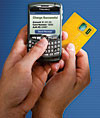App Cuts Credit Card Processing Time

After processing a customer’s credit card
payment, GoPayment can instantly send an e-mail or text receipt right from the
phone. Even though it’s shown working on a Blackberry here, it works on more
than 40 phones. (Courtesy of Intuit.)
So Jackson knows firsthand the potential delays to payment that can result from bad checks or having techs and installers take credit card numbers and not turn the information in until they get back to the office - which could take days.
Fortunately, new phone technology has led to applications that streamline these processes to the benefit of both the contractor and the customer.
And Jackson Comfort, a third-generation business based in Northfield, Ohio, has used this technology to its advantage. The family-owned-and-operated company has been in business since the 1940s and is a 60 percent residential, 40 percent commercial HVAC contractor with nine service techs, eight installers, and four salesmen.
NOT SO CONVENIENT
The contractor is well aware that payment of a major appliance repair can be a hardship for most people, especially when it’s unexpected. “Many times, when a furnace, air conditioner, or water heater breaks down, it’s a surprise expense for the homeowner,” Jackson said. “During extreme weather, HVAC emergency service is needed for health reasons and/or to prevent property damage.”Credit cards can be a convenience for the homeowner, though they are not infallible. From the contractor’s perspective, a credit card “helps keep our costs down, since we are assured the payment is good at the time of the repair,” she said. It also prevents some of the problems that can occur with a small number of personal checks, such as insufficient funds. “We’ve had our share of bad checks and [declined] credit cards in the past.”
Their effect on the bottom line is negative, of course, “and when you get a bad check, then you’ve got to chase people down for the rest of the money,” Jackson said. “Then you have to juggle to make your own payments.” Plus, it winds up costing the customer more money than they had orginally planned on spending.
Credit card payments used to be more complicated and less streamlined, she explained. “With some companies you have to call in to make the payment; the tech would write down the credit card number on the invoice, and we would process that.” One problem, according to Jackson, was, “Not all guys would come into the office all the time.” And federal law now mandates that retailers can’t write down card numbers.
There other problems, such as deciphering techs’ handwriting, and covering more expensive processing fees that are applied when the actual card isn’t swiped. That either gets passed on to the customer, or it erodes the contractor’s bottom line.
Enter a relatively new phone app called GoPayment. Intuit markets it as being able “to help small businesses process credit cards outside the office as soon as the job is done.”
“We started using GoPayment across our business in June 2009,” said Jackson. “That put us in compliance.”
Customers may not have voiced their concerns about having techs write down their card numbers, but “once we started with GoPayment, we got very positive feedback from customers. And now that the techs all use GoPayment, we receive the money in our account in one or two days.”
To further ease the payment process, the contractor asks what form of payment will be used as soon as the service call is booked. “They know they need to pay when the service tech is there.”
JUST MAKES SENSE
The app is free, Jackson continued. “Our techs use it on their existing Nextel i576 phones.” Nextel gave contractors a deal in June 2008, she said. “We were eligible for upgrades on our phones, and we could buy one, get four free. So everyone got new flip phones. We also equipped many of our techs with the Bluetooth card swipe that Intuit sells in addition to GoPayment. It’s faster than entering the credit card number manually and offers a better discount rate,” she continued.The vendor pays a fee for processing credit cards; “when we use the card swipe, we pay only 1.64 percent.” This is because the card reader guarantees that the card is present thus minimizing the risk of the transaction. “If we don’t use the card swipe and manually punch in the credit card numbers, including the security code and billing zip code, we pay a higher rate of 2.24 percent.”
“To save even more time, we are also able to download GoPayment transactions directly into QuickBooks instead of entering them manually,” which cuts down on potential errors still more.
“Before choosing GoPayment, we tried using another mobile service that charged $25 a month per user, plus higher transaction fees. We now pay a monthly user fee for one account, which lets us have all of our techs (up to 50) on the same account. So that’s a $400-a-month savings right there. The transaction fees are also less, so we’re saving another $200 to $500 per month, depending on the season. Over the next year, we expect to save $6,000 to $10,000.
“This offering has helped my business so much that at the HVAC conference in Philadelphia, I presented GoPayment in the ‘I’ve Got an Idea to Cut Costs’ segment,” Jackson said. “That tells it all!”
For more information, visit www.intuit.com.
Publication date: 06/28/2010



